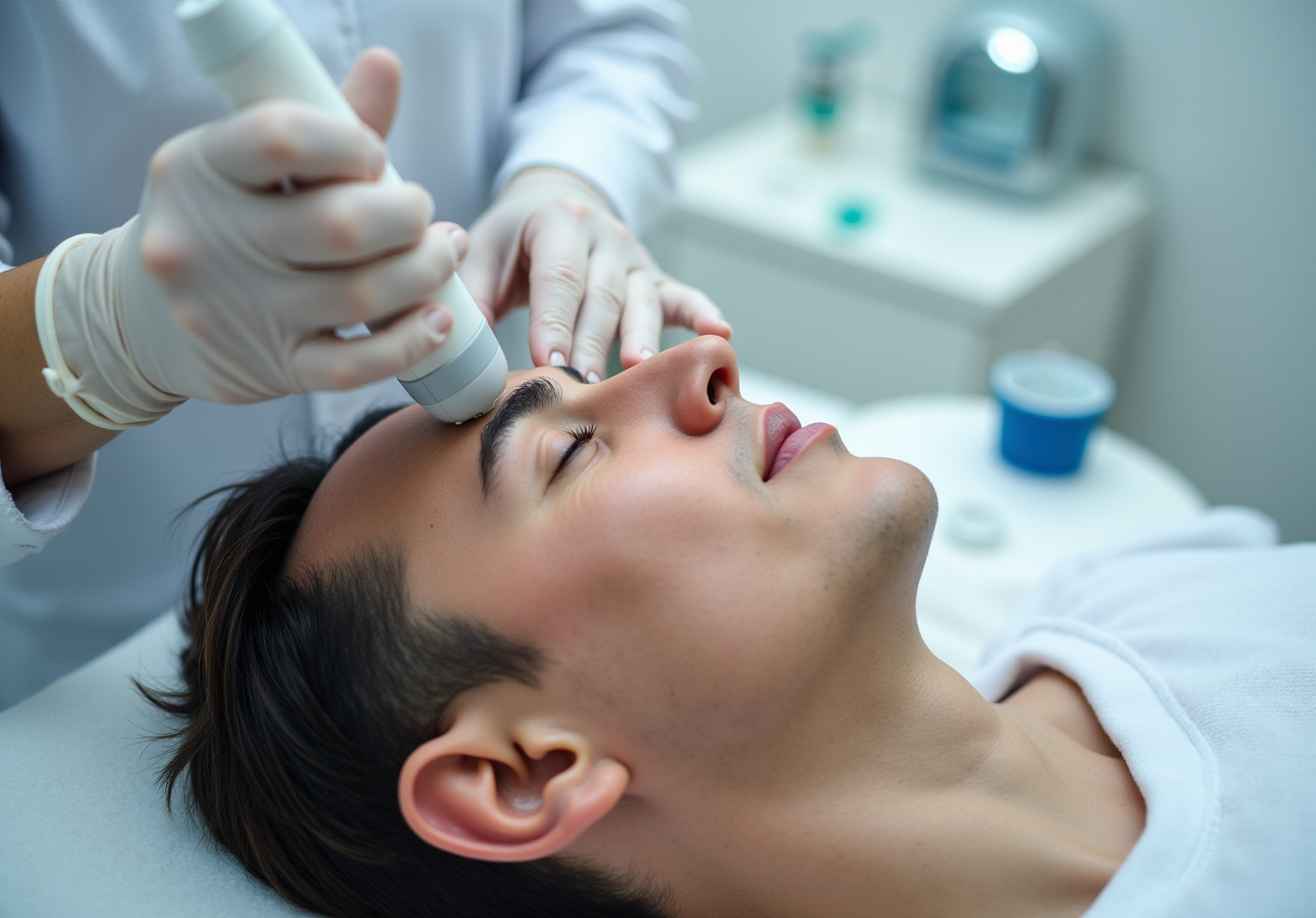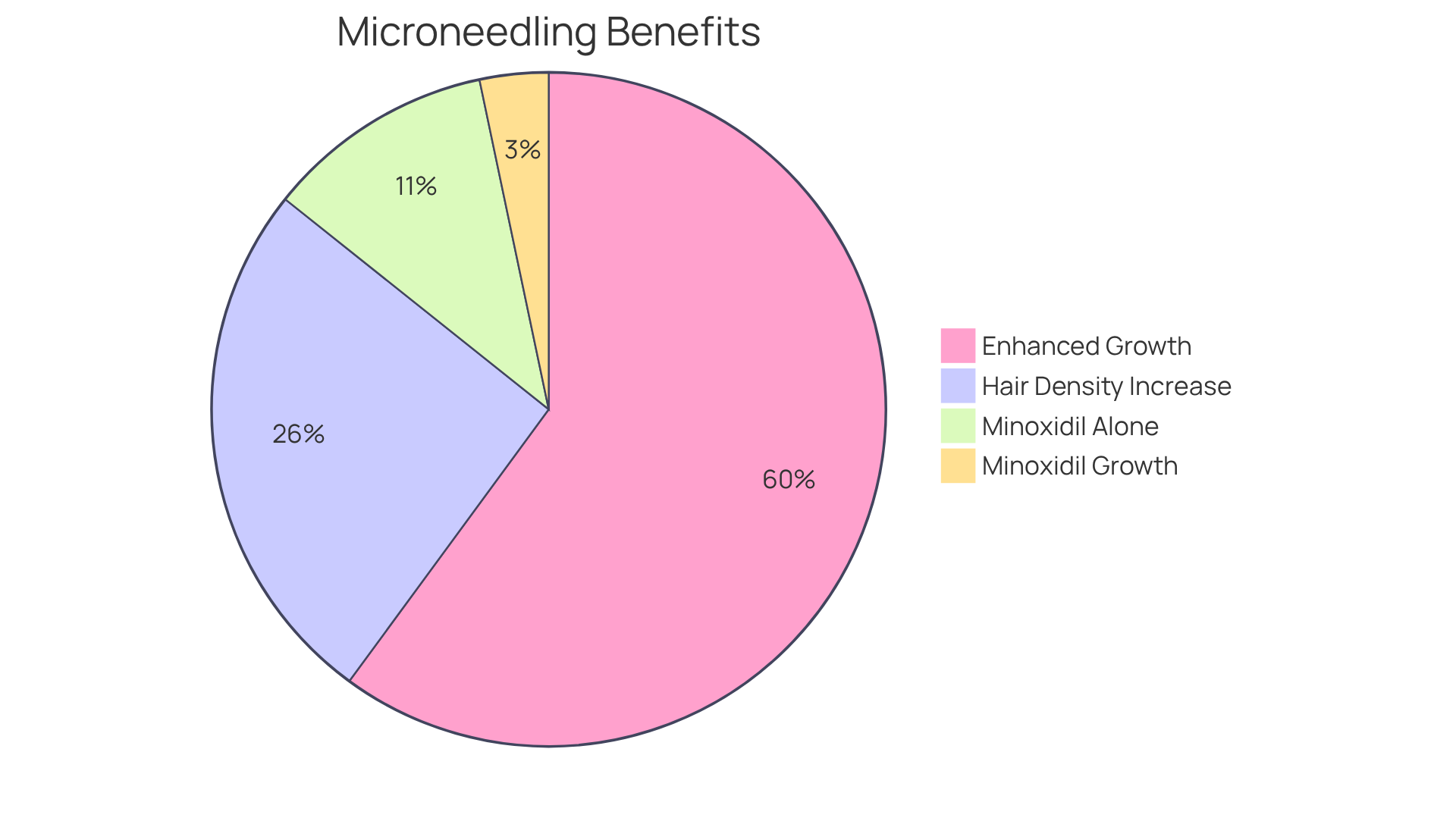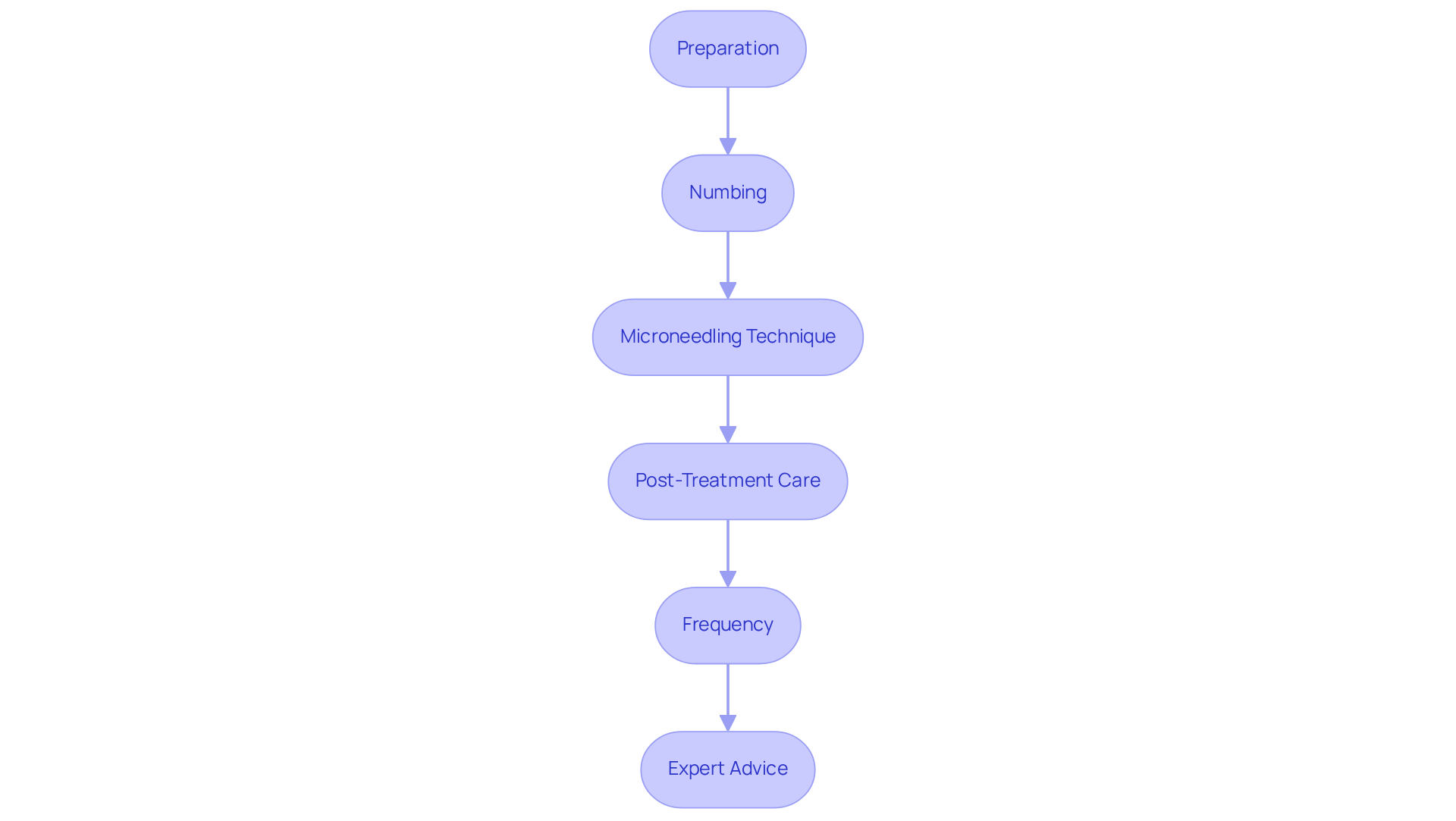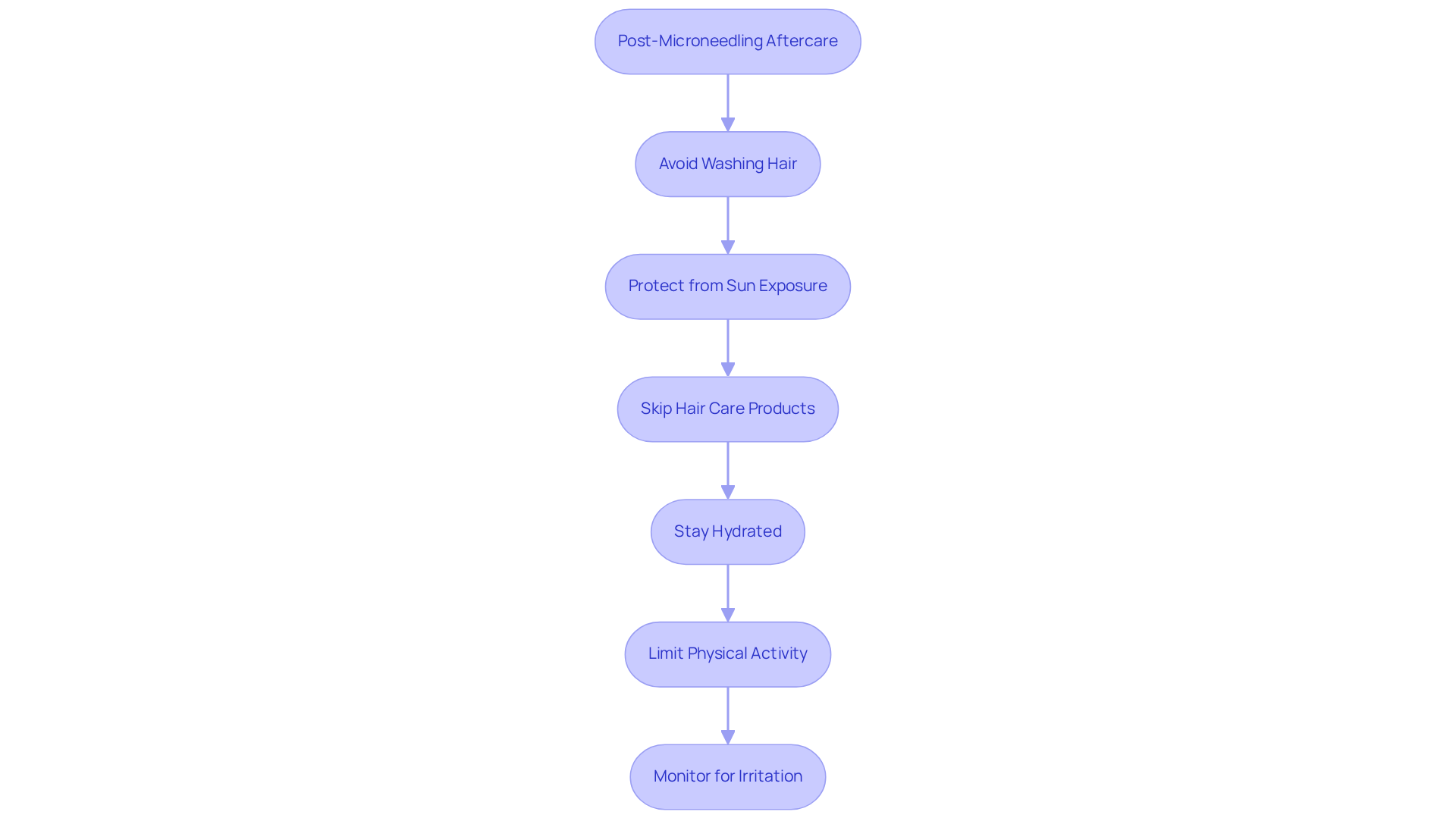Master Microneedling Hair Techniques for Optimal Results

Overview
Microneedling hair techniques are vital for achieving optimal outcomes in hair restoration. This procedure stimulates hair follicles and significantly enhances the effectiveness of topical treatments such as minoxidil. By promoting blood flow and collagen production, microneedling leads to substantial improvements in hair density and scalp health. As a result, it emerges as a promising solution for individuals facing hair loss.
For those seeking effective hair restoration methods, incorporating microneedling into their regimen is highly recommended.
Introduction
Microneedling hair restoration is swiftly emerging as a groundbreaking solution for individuals facing hair loss. This innovative technique not only stimulates hair follicles but also amplifies the effectiveness of topical treatments, providing a dual approach to achieving thicker, healthier hair. However, the path to optimal results presents its own set of challenges.
How can individuals master the microneedling process to maximize its benefits? This article explores essential techniques, step-by-step applications, and aftercare strategies designed to elevate microneedling practices, ultimately paving the way for successful hair restoration.
Understand Microneedling: Principles and Benefits for Hair Restoration
Microneedling hair, also known as collagen induction therapy, employs a device equipped with fine needles to create micro-injuries in the scalp. This innovative process of microneedling hair triggers the body's natural healing response, significantly enhancing blood flow and collagen production, which leads to several notable benefits for hair restoration.
By stimulating hair follicles, microneedling hair can result in thicker, healthier hair. Research indicates that patients undergoing micro-injections alongside topical therapies, such as minoxidil, observe a 35% enhancement in hair density after just six months. In contrast, those using minoxidil alone experience only a 15% increase.
-
Enhanced Scalp Wellness: The micro-injuries created by microneedling hair foster a healthier scalp environment, crucial for optimal follicle growth. Studies show that microneedle therapy effectively addresses conditions like androgenetic alopecia and alopecia areata, impacting over 6 million Americans.
-
Microneedling hair significantly improves the absorption of topical solutions, rendering applications like minoxidil more effective by enhancing the uptake of growth products. Clinical studies reveal that 82% of participants in the microneedle treatment group reported over a 50% enhancement in hair growth, compared to a mere 4.5% in the minoxidil-only group.
-
Non-Invasive Procedure: As a minimally invasive method, microneedling offers a safer alternative to surgical options, with minimal downtime for recovery. It is generally safe when performed by trained professionals.
The dual mechanism of this treatment not only stimulates new hair growth but also enhances the effectiveness of existing therapies, particularly with microneedling hair. This makes microneedling a promising choice for individuals facing hair loss challenges.

Explore Microneedling Techniques: Step-by-Step Application for Optimal Results
To achieve optimal results with microneedling for hair restoration, it is essential to follow these key steps:
-
Preparation: Begin by thoroughly cleansing your scalp to eliminate dirt and oils. Disinfect your microneedling device—whether it be a derma roller or pen—to prevent any risk of infection.
-
Numbing: Next, apply a topical numbing cream to your scalp, allowing it to sit for 30 minutes to minimize discomfort during the procedure.
-
For the microneedling hair technique, divide your scalp into sections for easier access. Using the needle device, gently roll or stamp over your head in a grid-like pattern, applying consistent pressure. It is crucial to avoid going over the same area multiple times to prevent irritation. Focus on regions with reduced density, ensuring even coverage across the entire scalp.
-
Post-Treatment Care: After microneedling, enhance results by applying a hair growth serum or PRP (platelet-rich plasma). Refrain from cleansing your hair for at least 24 hours to allow the scalp to recover adequately.
-
Frequency: For optimal outcomes, perform microneedling every 4-6 weeks, tailored to your specific hair restoration goals.
Experts emphasize that microneedling hair therapy can significantly boost scalp growth when combined with topical solutions such as minoxidil. Microneedling hair is a technique that not only stimulates hair follicles but also enhances blood circulation to the scalp, creating an ideal environment for hair regrowth. It is important to note that skin-needling sessions typically range in cost from $200 to $700, with potential side effects including redness, pain, or swelling. Always consult a licensed provider before attempting at-home microneedling to ensure both safety and effectiveness.

Implement Aftercare Strategies: Enhance and Sustain Your Microneedling Results
To maximize the benefits of SQT Bio-Microneedling and ensure proper healing, it is essential to adhere to the following aftercare strategies:
- Avoid Washing Your Hair: Refrain from washing your hair for at least 24-48 hours post-treatment to allow the scalp to heal effectively. It is also recommended to wait 24 hours before using any cleanser, ensuring it is non-exfoliating.
- Protect from Sun Exposure: Shield your scalp from UV rays by wearing a hat or applying a broad-spectrum sunscreen daily for a couple of weeks post-treatment. Sun exposure can irritate the treated area and hinder recovery.
- Skip Hair Care Products: Avoid using grooming products, particularly those with harsh chemicals, for at least 48 hours. Additionally, refrain from using styling products like gels, hair sprays, or waxes for at least a week to prevent irritation and support healing.
- Stay Hydrated: Drink ample water, aiming for at least eight glasses a day, to promote healing and maintain optimal hair health. Hydration is crucial during the recovery process.
- Limit Physical Activity: Avoid intense exercise for 48-72 hours to reduce excessive sweating, which can irritate the head and heighten the risk of complications.
- Monitor for Irritation: Keep a close watch on your scalp for any signs of irritation or infection. If you experience excessive redness, discomfort, or severe pain, consult a healthcare professional promptly.
By diligently following these aftercare tips, you can enhance and sustain the results of your SQT Bio-Microneedling procedure, which is essential for promoting microneedling hair growth over time. This innovative treatment, utilizing SQT Spongilla spicules, not only stimulates collagen production but also ensures a safe and effective recovery, setting the stage for optimal results.

Conclusion
Microneedling hair techniques present a revolutionary approach to hair restoration, harnessing the body’s natural healing mechanisms to foster healthier hair growth. This innovative method not only stimulates hair follicles but also enhances the efficacy of topical treatments, making it an attractive option for individuals confronting hair loss challenges.
The principles and benefits of microneedling are substantial, as it significantly improves scalp health, increases blood circulation, and boosts hair density. Key techniques for successful application are thoroughly outlined, alongside essential aftercare strategies that ensure optimal results. Adhering to these guidelines can lead to a more effective and rewarding experience in hair restoration.
Ultimately, embracing microneedling as a viable solution for hair loss can transform one’s approach to hair care. By understanding its benefits and implementing best practices, individuals can take proactive steps toward achieving thicker, healthier hair. For anyone contemplating this innovative treatment, conducting thorough research and consulting with professionals is crucial to ensure safety and effectiveness in the pursuit of hair restoration.
Frequently Asked Questions
What is microneedling hair?
Microneedling hair, also known as collagen induction therapy, is a procedure that uses a device with fine needles to create micro-injuries in the scalp, triggering the body's natural healing response to enhance blood flow and collagen production.
What are the benefits of microneedling for hair restoration?
Microneedling can lead to thicker, healthier hair by stimulating hair follicles and improving scalp wellness. It also enhances the absorption of topical solutions, making treatments like minoxidil more effective.
How effective is microneedling compared to minoxidil alone?
Research indicates that patients undergoing microneedling alongside topical therapies like minoxidil experience a 35% enhancement in hair density after six months, compared to only a 15% increase for those using minoxidil alone.
What scalp conditions can microneedling help address?
Microneedling therapy effectively addresses conditions such as androgenetic alopecia and alopecia areata, which impact over 6 million Americans.
How does microneedling improve the effectiveness of topical solutions?
Microneedling significantly improves the absorption of topical solutions, leading to better uptake of growth products. Clinical studies show that 82% of participants in the microneedling treatment group reported over a 50% enhancement in hair growth.
Is microneedling a safe procedure?
Yes, microneedling is a minimally invasive method that is generally safe when performed by trained professionals, with minimal downtime for recovery.
Who should consider microneedling for hair loss?
Microneedling is a promising choice for individuals facing hair loss challenges, especially those looking to enhance the effectiveness of existing therapies or seeking a non-invasive alternative to surgical options.


